Bottlenose dolphins have been the subject of Tethys’ scientific interests very early in the institute’s life. Over the years, Tethys’ researchers have contributed to the accumulation of knowledge relevant to the species’ conservation (Bearzi et al. 2009) Activities included:
- the conduction of a long-term research programme (1987-1999), the Adriatic Dolphin Project (ADP), based on the island of Lošinj (Croatia) and adjacent waters, producing a large body of substantive ecological knowledge (Bearzi et al. 1997, 1999) on the local population of common bottlenose dolphins. Concern for the survival of the population, threatened mainly by very high level of small vessel traffic during summer, prompted Tethys to propose the local establishment of a protected area for the dolphins, the Cres-Lošinj Marine Protected Area (Balenovic 1992). Upon the decision by Tethys to terminate the ADP in 1999, the baton of the scientific and conservation work on the local dolphins was passed to former ADP researchers, who in the meantime had created Blue World, a Croatian NGO;
- a study of the ecology of bottlenose dolphins in the Northern Adriatic Sea, and their relationships with local oceanographic conditions (2003-2006) (Bearzi et al. 2008A);
- the conduction of a second long-term research programme (1991-present), the Ionian Dolphin Project (IDP), based in the Inner Ionian Sea Archipelago (Greece), and extended in 2001 in the nearby semi-enclosed and eutrophic Gulf of Ambracia (Greece), hosting a community of roughly 150 dolphins (Bearzi et al 2008B). While this is among the highest densities for this species recorded anywhere in the Mediterranean Sea, it is not indicative of favourable conservation status or pristine habitat. This highly resident population is at risk due to their small population size and low immigration rates, as well as to acute and growing anthropogenic impacts resulting in an increasingly degraded ecosystem (Gonzalvo et al 2015);
- studies on abundance estimates, distribution and movements of bottlenose dolphins in the western Mediterranean, and in particular in the Pelagos Sanctuary (Gnone et al. 2011, Lauriano et al. 2014).
Literature
Bearzi G., Fortuna C.M., Reeves R.R. 2009. Ecology and conservation of common bottlenose dolphins Tursiops truncatus in the Mediterranean Sea. Mammal Review 39(2):92-123. DOI 10.1111/j.1365-2907.2008.00133.x
Bearzi G., Notarbartolo di Sciara G., Politi E. 1997. Social ecology of bottlenose dolphins in the Kvarneric (northern Adriatic Sea). Marine Mammal Science 13(4):650-668.
Bearzi G., Politi E., Notarbartolo di Sciara G. 1999. Diurnal behavior of free-ranging bottlenose dolphins in the Kvarneric (northern Adriatic Sea). Marine Mammal Science 15(4):1065-1097.
Balenovic V., Bearzi G., Notarbartolo di Sciara G., Bonomi L., Zahtila E. 1992. The Cres-Losinj dolphin reserve: proposal for the institution of a Marine reserve in the waters adjacent to the eastern coast of Cres and Losinj. Tethys Research Institute, Milan and CRM Rudjer Boskovic, Rovinj. Veli Losinj, July 1992. 14 p.
Bearzi G., Azzellino A., Politi E., Costa M., Bastianini M. 2008. Influence of seasonal forcing on habitat use by bottlenose dolphins Tursiops truncatus in the Northern Adriatic Sea. Ocean Science Journal 43(4):175-182.
Bearzi G., Agazzi S., Bonizzoni S., Costa M., Azzellino A. 2008. Dolphins in a bottle: abundance, residency patterns and conservation of bottlenose dolphins Tursiops truncatus in the semi-closed eutrophic Amvrakikos Gulf, Greece. Aquatic Conservation: Marine and Freshwater Ecosystems 18:130-146. DOI: 10.1002/aqc.843
Gonzalvo J., Giovos I., Mazzariol S. 2015. Prevalence of epidermal conditions in common bottlenose dolphins (Tursiops truncatus) in the Gulf of Ambracia, western Greece. Journal of Experimental Marine Biology and Ecology 463:32-38. http://dx.doi.org/10.1016/j.jembe.2014.11.004
Gnone G., Bellingeri M., Dhermain F., Dupraz F., Nuti S., Bedocchi D., Moulins A., Rosso M., Alessi J., McCrea R.S., Azzellino A., Airoldi S., Portunato N., Laran S., David L., Di Meglio N., Bonelli P., Montesi G., Trucchi R., Fulvio Fossa F., Wurtz M. 2011. Distribution, abundance and movements of the bottlenose dolphin (Tursiops truncatus) in the Pelagos Sanctuary MPA (North-West Mediterranean Sea). Aquatic Conservation: Marine and Freshwater Ecosystems 21:372-388. DOI: 10.1002/aqc.1191
Lauriano G., Pierantonio N., Donovan G., Panigada S. 2014. Abundance and distribution of Tursiops truncatus in the Western Mediterranean Sea: an assessment towards the Marine Strategy Framework Directive requirements. Marine Environmental Research 100:86-93. http://dx.doi.org/10.1016/j.marenvres.2014.04.001


